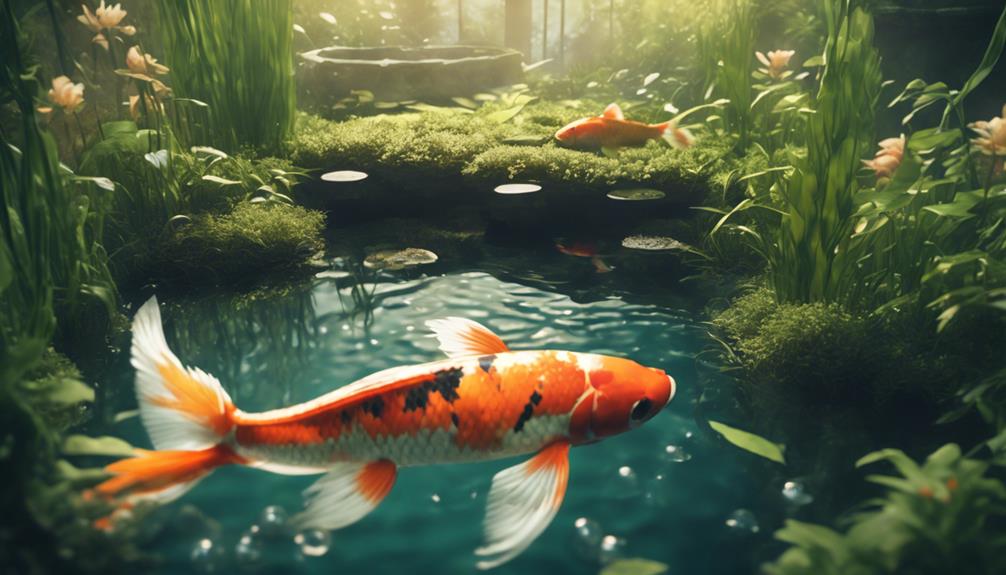You'll increase your chances of successfully spawning koi fish by replicating their natural breeding conditions. A sudden increase in water temperature to between 65°F and 75°F can stimulate koi to spawn, as can longer daylight hours and an abundance of food. By creating an ideal environment with perfect water quality, suitable pond plants, and a consistent temperature, you'll encourage koi to breed. Now that you've got the basics covered, you're just a step away from discovering the secrets to successful koi spawning.
Table of Contents
Key Takeaways
- A sudden increase in water temperature between 65°F to 75°F can stimulate koi to spawn.
- Longer daylight hours can trigger spawning, mimicking their natural breeding season.
- A sudden abundance of food can stimulate koi to spawn, signaling an ideal time for reproduction.
- Recognizing and replicating their natural habitat, including perfect water quality, is imperative for successful spawning.
- Temperature control is vital, with koi typically spawning when water temperatures rise to 64°F to 75°F (18°C to 24°C).
Understanding Koi Spawning Triggers
When you provide the right environment, koi fish can be triggered to spawn, but understanding what stimulates this behavior is crucial to inducing successful breeding.
You'll want to know that koi spawning is influenced by a combination of factors, including water temperature, daylight hours, and the availability of food.
For instance, a sudden increase in water temperature, typically between 65°F to 75°F, can stimulate koi to spawn.
Similarly, longer daylight hours can also trigger spawning, as it mimics their natural breeding season.
Additionally, a sudden abundance of food can stimulate koi to spawn, as it signals an ideal time for reproduction.
By understanding these triggers, you can create an environment that encourages your koi to spawn successfully.
Recognizing that koi spawning is a natural process is imperative, and by replicating their natural habitat, you can increase the chances of successful breeding.
Creating Ideal Spawning Conditions
To create ideal spawning conditions, you'll need to carefully manipulate the water environment to mimic the natural triggers that stimulate koi spawning, focusing on precise temperature control, perfect water quality, and a well-designed spawning area.
Temperature control is vital. Koi typically spawn when water temperatures rise to 64°F to 75°F (18°C to 24°C). You can achieve this by gradually increasing the water temperature over a few days or weeks, simulating the natural warming of ponds in spring.
Next, perfect water quality is essential. Regularly test the water for ammonia, nitrite, and nitrate levels, ensuring they're within safe ranges. Perform partial water changes to maintain top-notch water quality. You can also add plants or a biofilter to help maintain a balanced ecosystem.
Lastly, design a well-planned spawning area. Provide plenty of vegetation, such as water wisteria or hornwort, for the koi to spawn around. You can also add a spawning mat or a shallow area with a gentle water flow to simulate the natural environment. By controlling these factors, you'll create an ideal environment for your koi to spawn successfully.
Koi Mating and Spawning Process
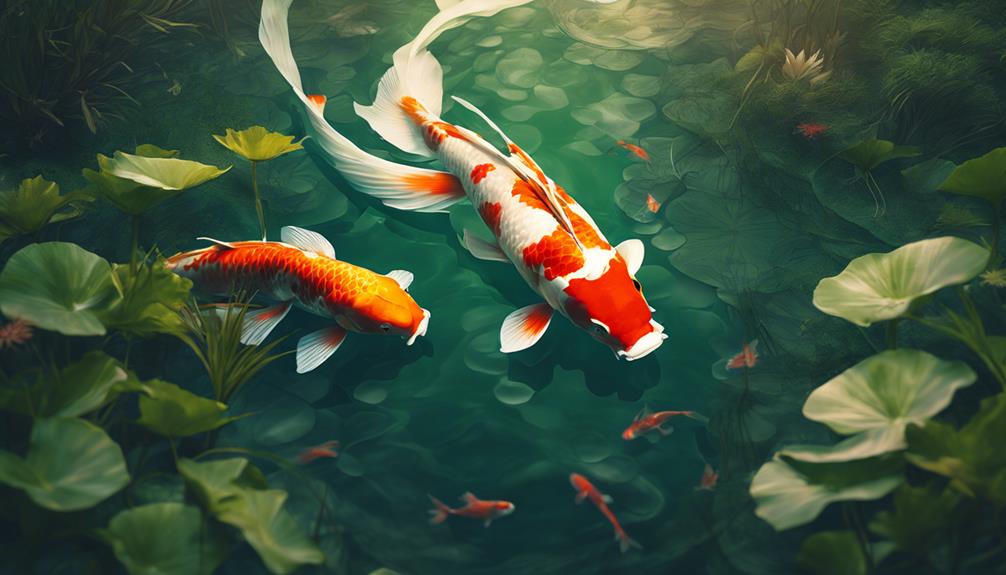
You'll witness a fascinating display of koi mating and spawning process, characterized by males vigorously chasing females around the pond, as they prepare to release their eggs.
This spawning behaviour typically occurs when water temperatures are between 65°F to 70°F, usually in late spring or early summer.
As you observe the males' pursuit, you'll notice them nudging the females' sides with their mouth and fins, encouraging them to lay their eggs.
Immediately after the eggs are released, the males will fertilize them. Females can lay up to 400,000 eggs, which are sticky and adhere to surfaces.
You might notice foam appearing on the surface of the pond, especially around waterfalls or aerators, as a result of the spawning process.
Repeated spawning can occur in a short period, and it's not uncommon for koi to spawn at night, making it difficult to detect.
As you understand the intricacies of the koi mating and spawning process, you'll appreciate the complexity of their spawning behaviour and what triggers it to occur successfully.
Optimizing Pond Environment
As you prepare your pond for koi spawning, you'll need to focus on optimizing three critical factors: pond water temperature, pond plant selection, and pond water quality.
You'll want to guarantee your pond's temperature is within the ideal range for spawning, select plants that provide suitable habitat for your koi, and maintain impeccable water quality to support the spawning process.
Pond Water Temperature
Controlling pond water temperature is essential, since it plays a pivotal role in triggering koi spawning, with the ideal range falling between 65°F to 70°F for perfect breeding conditions. You'll want to maintain a consistent temperature between 18°C to 22°C (64°F to 72°F) to increase the chances of successful spawning.
| Temperature (°F) | Temperature (°C) | Effect on Spawning |
|---|---|---|
| 65°F – 70°F | 18°C – 21°C | Ideal spawning conditions |
| Below 65°F | Below 18°C | Delayed or inhibited spawning |
| Above 70°F | Above 21°C | Stress and reduced spawning |
A sudden warming of water temperature, typically in late spring or summer, stimulates koi to spawn. In fact, koi need to experience 1000-degree days to mature and spawn, making temperature control fundamental for successful breeding. Remember, water temperature and day length work together to influence spawning, with increasing day length having the greatest effect on maturing female eggs. By controlling water temperature, you'll be well on your way to creating the perfect environment for your koi to thrive and spawn successfully.
Pond Plant Selection
By carefully selecting the right pond plants, you can optimize your pond environment, which in turn will help create a thriving ecosystem that supports the health and fertility of your koi, ultimately leading to successful spawning.
When choosing pond plants, it's vital to weigh their role in maintaining a balanced ecosystem. Aquatic plants like water lettuce, water hyacinth, and hornwort are excellent options as they provide shade, reduce algae growth, and create hiding places for your koi. These plants will also help to stabilize the pond's pH levels and oxygenate the water. Additionally, they'll serve as a natural food source for your koi, promoting healthy digestion and growth.
To guarantee the plants thrive, make sure to provide them with the right amount of sunlight, nutrients, and water circulation. You can also add decorative plants like lily pads and cattails to create a visually appealing environment. By incorporating a diverse range of pond plants, you'll be creating a haven for your koi to flourish, increasing the chances of successful spawning.
Pond Water Quality
Regularly testing and maintaining superior water quality is crucial to creating a thriving environment that supports the health and fertility of your koi, ultimately leading to successful spawning. You want to guarantee your pond's water quality is ideal, as poor water conditions can stress your fish, making them less likely to spawn.
To achieve this, you'll need to monitor and control factors such as ammonia, nitrite, and nitrate levels, as well as pH, alkalinity, and water hardness.
Regularly test your pond's water for ammonia, nitrite, and nitrate levels, and make adjustments as necessary.
Perform partial water changes (about 10-20% every week) to remove built-up toxins and maintain ideal water chemistry.
Guarantee proper aeration and circulation to prevent stagnant water and promote healthy oxygen levels.
Add beneficial bacteria supplements to maintain a balanced ecosystem and break down waste efficiently.
Ensuring Fry Survival and Growth
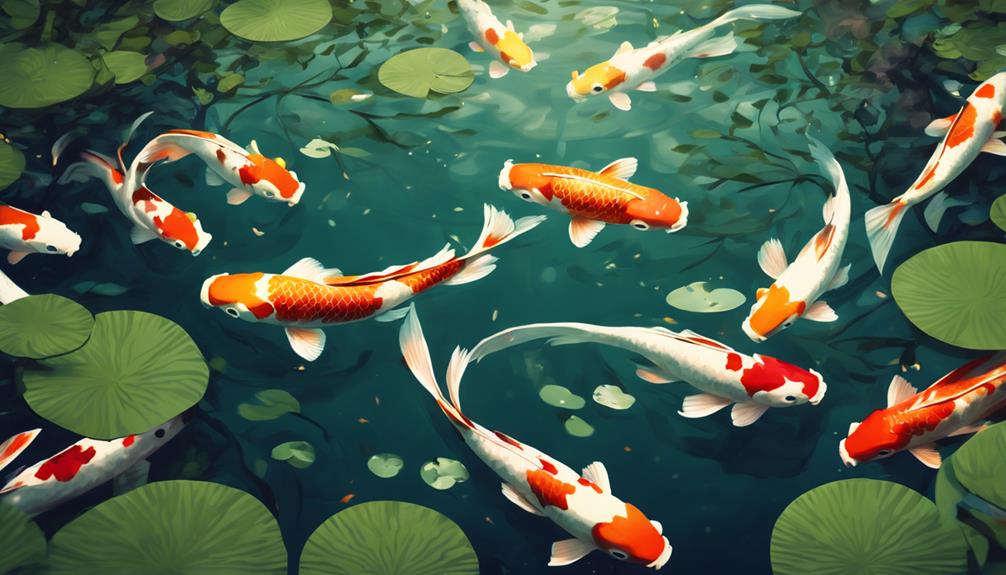
To guarantee the survival and growth of your koi fry, it is vital to provide them with a diet rich in protein and fat, as inadequate nutrition can hinder their development and even lead to mortality.
You'll want to secure they've a suitable environment with plenty of hiding places, such as plants or artificial structures, to reduce stress and increase their chances of survival.
Regular water changes and careful feeding are essential for fry growth and survival.
Poor water quality and inadequate nutrition can lead to high mortality rates, so it's vital to monitor their environment closely.
You'll also need to separate your fry from larger fish to prevent predation, as even small koi can view them as a food source and eat them.
Managing Water Quality Issues
As you focus on nurturing your koi fry, you'll simultaneously need to manage the water quality issues that arise after spawning, when the release of eggs and sperm can lead to a sudden spike in ammonia levels. This is a critical period, as the high-protein products from the eggs and sperm can break down into ammonia, threatening the health of your fish.
To mitigate this issue, you'll need to take proactive steps.
Regular water testing is vital to monitor water quality, especially ammonia levels, after spawning.
Performing partial water changes may be necessary to maintain good water quality and prevent ammonia buildup.
Beneficial bacteria like Natures Defense or Muck Defense can break down waste and help maintain good water quality.
The Pond Guy Stress Reducer Plus can remove chlorine and toxic heavy metals from tap or well water, helping to maintain good water quality.
Koi Breeding Prevention Methods
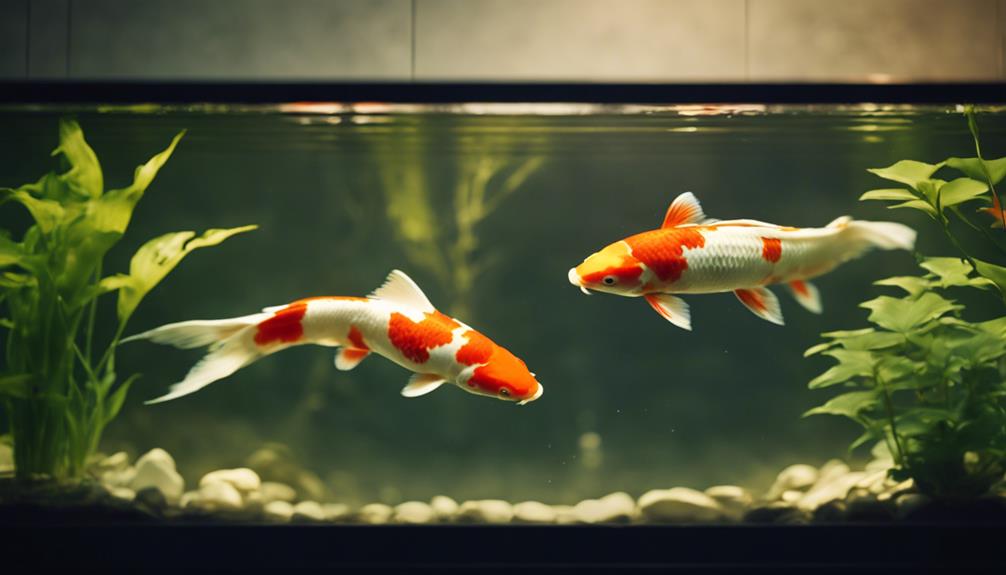
When you're trying to prevent koi breeding, you'll need to understand what triggers spawning in the first place.
You'll want to identify and eliminate or reduce these triggers, such as sudden changes in water temperature or chemistry, to prevent your fish from reproducing.
Preventing Spawning Triggers
You can substantially reduce the likelihood of koi spawning in your pond by identifying and controlling the environmental cues that trigger this natural process. By understanding what triggers spawning, you can take steps to prevent it from happening in the first place. This is especially important if you're not interested in breeding koi or don't want to deal with the added maintenance that comes with a sudden population boom.
To prevent spawning, keep the following in mind:
- Maintain a stable water temperature: Avoid sudden changes in water temperature, as this can trigger spawning. Keeping your pond at a consistent temperature between 65°F and 75°F can help prevent spawning.
- Keep your pond clean: Regular water changes and a well-maintained filtration system can help reduce the buildup of hormones that trigger spawning.
- Provide adequate hiding places: Koi need a place to hide and feel secure, so make sure your pond has plenty of plants, rocks, or other hiding spots.
- Avoid overfeeding: Overfeeding can lead to an increase in hormones that trigger spawning, so make sure to only feed your koi what they can consume within a few minutes.
Separating Males and Females
By segregating males and females, you can physically prevent them from mating, making it an effective method for koi breeding prevention. This approach is particularly useful when you're not planning to breed your koi or want to control the population.
To separate them, you'll need to identify the gender of your koi, which can be a bit challenging. Males tend to be slender and have a more pointed fin, while females are generally rounder and have a more rounded fin. You can also look for the vent area, which is usually more convex in females.
Once you've identified the males and females, you can separate them into different tanks or ponds. Make sure the tanks or ponds are identical regarding water quality, temperature, and other conditions to prevent stress.
You can also use a breeding tank with a divider to keep the males and females apart while still allowing them to coexist. By separating males and females, you can effectively prevent unwanted breeding and maintain a healthy, thriving koi population. This method is especially useful for koi enthusiasts who want to maintain a specific breed or color variation.
Post-Spawning Care and Management
After spawning, it's essential to shift your focus to post-spawning care and management to guarantee the health and survival of your koi fish. You've successfully triggered spawning, but now it's pivotal to safeguard the well-being of your fish during this critical period.
Monitor water quality, especially ammonia levels, as the reproduction process can cause a spike in ammonia levels that can be harmful to the fish. Perform partial water changes if necessary to maintain good water quality and prevent the buildup of toxins.
Provide a steady supply of food for baby koi as they feed constantly, and guarantee the food is nutritious and suitable for their developmental stage.
Be prepared to separate baby koi from larger fish to prevent predation, and consider using a separate nursery tank or area to protect the young fry.
Koi Spawning Behaviour and Development
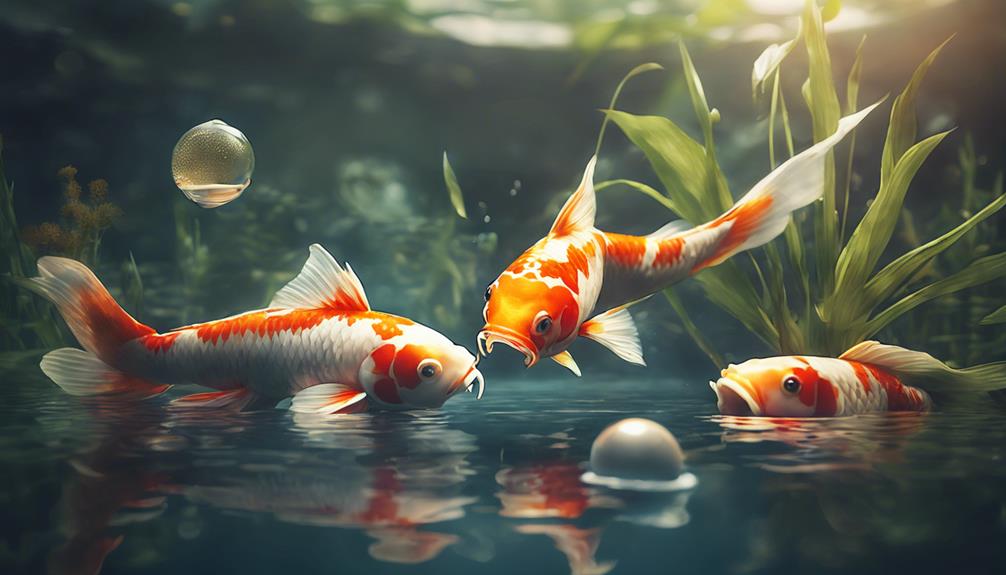
As you prepare for koi spawning, you'll want to understand the triggers that set it off, the specific environment needs for successful spawning, and the intricate process of egg development.
You'll need to create a favorable environment that meets the unique requirements of your koi, such as water temperature and vegetation, to encourage healthy spawning behaviour.
Koi Spawning Triggers
During the breeding season, you'll notice a significant change in your koi's behavior, triggered by a complex interplay of environmental cues that signal the start of the spawning process. As day length increases, your koi will begin to prepare for spawning. Females will release pheromones, signaling to males that it's time to get ready. You'll notice males following females closely around the pond edges, exhibiting increased interest in them.
Water temperature is typically around 20°C/68°F when koi spawning is triggered.
Day length is another important factor, as longer days signal to koi that it's time to spawn.
Hormonal signals also play a crucial role, with females releasing pheromones to signal to males that they're ready to spawn.
Environmental cues, such as changes in water quality, flow, and light, can also trigger spawning behavior.
Spawning Environment Needs
When setting up a spawning environment, you'll want to provide your koi with an ideal breeding habitat, complete with vegetation or artificial alternatives, to facilitate a successful spawning process. Koi prefer to deposit eggs in vegetation, such as hornwort, water hyacinths, or water lettuce, which provides a natural area for spawning and protects females from being chased into hard pond edges. If natural vegetation is not available, artificial spawning mops or ropes can be used.
Here's a breakdown of the ideal spawning environment:
| Parameter | Optimal Condition | Effect on Spawning |
|---|---|---|
| Water Temperature | 20°C/68°F | Faster egg development and hatching |
| Vegetation | Natural or artificial | Provides a safe area for spawning and egg development |
| Water Quality | Clean and well-oxygenated | Supports healthy egg development and hatching |
| Pond Edges | Soft and gentle | Prevents female koi from being injured during spawning |
| Food Availability | Abundant infusoria and prey | Supports growth and survival of baby koi |
Egg Development Process
Koi eggs, which are opaque spheres that stick to surfaces, undergo rapid development and hatching in warm water temperatures, typically around 20°C/68°F. This ideal environment triggers the eggs to hatch within 3-4 days, and the newly hatched fry will feed from their yolk sac for a few days before searching for food in the water.
A large mature female koi can produce up to 400,000 eggs, which are sticky and adhere to surfaces. Males fertilize the eggs immediately after they're released, ensuring a successful spawn.
The eggs will hatch in about 3-4 days in warm water temperatures, and the fry will start eating food found in the water soon after. As the juveniles grow, they'll begin to feed on infusoria and larger prey, requiring a steady supply of food as they feed constantly.
Environmental Cues and Stimuli
Your koi fish rely on specific environmental cues and stimuli to trigger spawning, and understanding these factors is essential for successful breeding. Water temperatures, in particular, play a pivotal role in stimulating spawning. Ideal spawning temperatures range from 65°F to 70°F, and changes in water temperature can influence the spawning process.
| Environmental Cues | Effect on Spawning | Ideal Conditions |
|---|---|---|
| Water Temperature | Triggers spawning | 65°F to 70°F |
| Day Length | Stimulates egg maturation | Increasing day length |
| Cold Period | Increases spawning chances | 4°C or below for 1 month |
| Degree Days | Matures fish for spawning | 1000-degree days |
Spawning Area Design and Maintenance
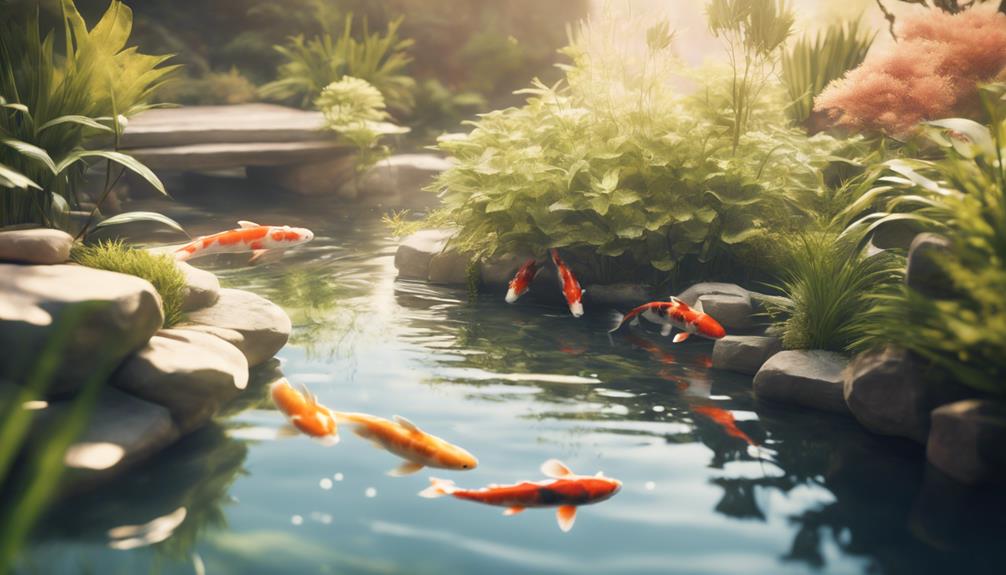
Properly designing and maintaining a spawning area is crucial to maximize breeding success, as koi fish are highly sensitive to their environment during this critical phase. You'll want to create an area that mimics their natural habitat, providing the right conditions for successful spawning. This includes guaranteeing the water is calm, with minimal currents and adequate hiding places for the fish.
Create a separate area for spawning, away from the main pond, to minimize distractions and stress.
Use materials like spawning mats, vegetation, or artificial spawning surfaces to provide a comfortable and secure environment for the fish to lay their eggs.
Regularly test and adjust water parameters, such as pH, ammonia, and nitrite levels, to guarantee a healthy environment for the fish.
Keep the water temperature between 18°C and 22°C, as sudden changes can disrupt the spawning process.
Frequently Asked Questions
What Are the Conditions for Koi to Spawn?
You need ideal water quality for koi to spawn, including temperatures between 65°F to 70°F, stable pH and ammonia levels, and sufficient oxygen, ensuring a healthy environment for your fish to thrive and reproduce successfully.
How Do You Encourage Fish to Spawn?
You can encourage fish to spawn by maintaining excellent water quality, which involves regular water changes, monitoring ammonia and nitrite levels, and ensuring a balanced ecosystem, creating a stress-free environment that fosters successful spawning.
What Triggers Fish to Spawn?
When you're trying to trigger spawning, you'll want to focus on mate selection, as fish naturally choose partners based on factors like size, color, and finnage, so create an environment that facilitates ideal pairing and increases the chances of successful spawning.
What Time of Day Do Koi Spawn?
You'll notice koi spawn during early mornings, typically between 6-10 am, when water temperature and light levels are ideal, as these conditions trigger their natural instinct to reproduce, ensuring successful spawning.
Conclusion
Successfully spawning koi fish requires a deep understanding of their unique needs and behaviors.
By replicating their natural environment, refining water quality, and providing the right cues, you can increase the chances of a successful spawn.
But, will you be able to create the perfect storm of conditions to trigger this complex process?
With attention to detail and a commitment to providing ideal care, the answer lies in your hands.

